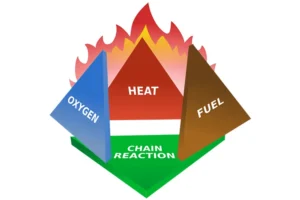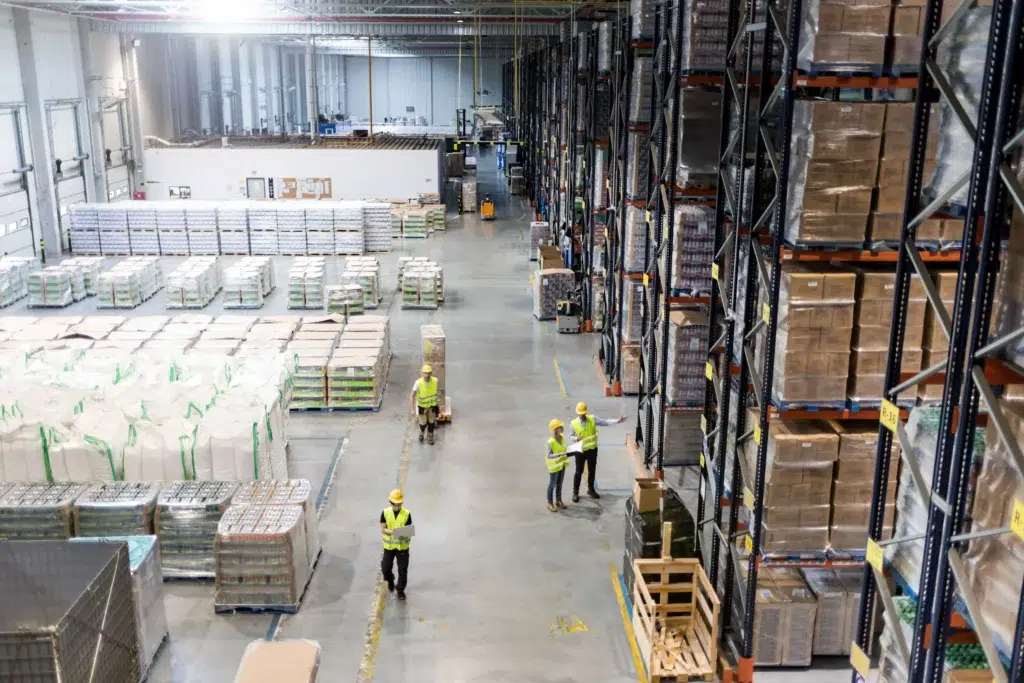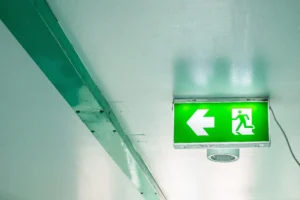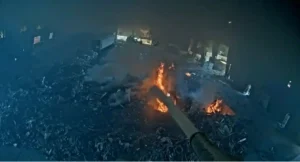
Preventing Fires through Effective Business Housekeeping
Understanding the science of the fire triangle—comprising heat, fuel, and oxygen—is essential for preventing fires. Here’s how to apply this knowledge to maintain a fire-safe workplace.
Book your FREE, no-strings-attached Fire Safety Audit to ensure that you’re properly protected from the risk and comply with current fire safety legislation.
Get essential insights and updates
in fire safety – straight to your inbox!

Fire safety is a critical concern in factories and warehouses due to the potential for significant harm to both individuals and assets. These environments often house flammable materials, heavy machinery, and complex operations, making them susceptible to fires that can spread rapidly and cause extensive damage.
To address these risks effectively, it’s essential for businesses to implement robust fire safety measures tailored to their specific industrial setting.
This article aims to provide practical and easy-to-follow tips that can help companies mitigate fire hazards and enhance overall safety levels.
To help you consider how you can prevent fire, we’ve collated fifteen tips for your business here at Blazequel. Let’s explore these fire safety tips in detail.
Ensure that fire alarms are installed throughout the facility, including in all work areas, storage areas, and corridors. Regularly test and maintain these alarms to ensure they are functioning properly. If activities take place that involve high levels of noise, ensure that visual alarm devices (flashing beacons) are installed as well as sounders.
Develop a detailed fire evacuation plan that includes evacuation routes, assembly points, and procedures for accounting for all employees during an evacuation. Conduct regular fire drills to ensure all employees are familiar with the plan.
Fire doors are crucial for slowing the spread of fire and smoke and protecting key evacuation routes. Different resistance times are available based on your building’s requirements. Install, maintain, and regularly inspect fire doors to ensure their functionality and integrity.
If they need to remain open, install magnetic door retainers, so that in the event of a fire alarm activation, that all the doors will automatically close, and any access control is disabled.
Place fire extinguishers at strategic locations throughout the facility, especially near areas with a higher risk of fire, such as machinery, storage areas, and kitchens. Train employees on how to properly use fire extinguishers.
Keep all exit routes clear of obstructions, including stored materials, equipment, and debris. Ensure that exit doors open easily and are not blocked.
Conduct fire risk assessments regularly, especially after any major changes to your premises. These assessments provide an overview of hazards, identify people at risk, highlight necessary training, and suggest ways to reduce risks effectively.
Regularly inspect and maintain machinery to prevent overheating or electrical faults that could lead to fires. Implement proper procedures for the storage and handling of flammable materials and chemicals.
Ensure that all portable electrical equipment is in good condition and safe to use. Portable Appliance Testing (PAT) helps identify potential dangers so they can be resolved before causing any damage.
Consider installing automatic sprinkler systems, especially in areas with a high fire risk. These systems can help suppress fires quickly, minimizing damage and risk to personnel.
Along the lines of ‘side-by-side comparision of a sprinkler protected storage rack fire vs non-protected.
Store flammable materials in designated areas that are properly ventilated and equipped with appropriate containment measures. Ensure that these materials are stored away from potential sources of ignition.
Ensure that all employees receive comprehensive training on fire safety procedures, including how to identify fire hazards, evacuate safely, and respond appropriately in the event of a fire. It‘s important to conduct regular refresher training sessions to keep everyone informed and prepared.
Also, always have designated, capable individuals who are responsible for implementing fire safety measures. Fire warden training is an excellent way to provide them with the knowledge and skills needed to carry out their role effectively, as required by the Regulatory Reform (Fire Safety) Order 2005.
Regularly inspect and maintain electrical systems to prevent overloads, short circuits, and other electrical faults that could lead to fires. Ensure that electrical panels are easily accessible and not blocked.
Install emergency lighting to ensure that exit routes remain illuminated in the event of a power outage during a fire emergency. Emergency lighting should be tested regularly to ensure functionality.
If smoking is permitted on the premises, designate specific smoking areas away from flammable materials and provide proper receptacles for cigarette disposal. Enforce strict rules regarding smoking outside designated areas.
Conduct regular fire safety inspections of the facility to identify and address any potential hazards or violations of fire safety regulations. Corrective actions should be taken promptly.
Blazequel is a leading fire protection service company located in Bedford and Northern Ireland. We specialise in providing fire safety solutions for high-risk industries, including waste management, manufacturing, and industrial sectors.
As a full-service fire protection provider, we handle everything from design, installation, testing, inspection and maintenance.
If you need more information or would like to schedule a consultation, please call our Bedford office at +44 1234 357357 or our Northern Ireland office at +44 28 7137 7775.
“We simplify fire safety for our clients, which saves you time, ensures your peace of mind, and allows you to focus on running your business.”

Understanding the science of the fire triangle—comprising heat, fuel, and oxygen—is essential for preventing fires. Here’s how to apply this knowledge to maintain a fire-safe workplace.

Ensuring the safety of your premises goes beyond just fortifying against potential intruders; it’s equally crucial to prioritize ease of evacuation, particularly in today’s climate of heightened crime rates and

In the waste and recycling industry, the risk of fire is significant. Early detection and targeted suppression are crucial for preventing disasters. Advanced sensors alert workers to potential fires, allowing
Video Smoke Detection is perfect for a fast response to fires in high roofed buildings and harsh operating conditions.
Watch Smokecatcher detect smoke in an MSW storage building. The smoke is coming through from a fire in the adjoining storage area.
Watch Smokecatcher detect a fire in an SRF Storage bunker. Sadly, the alarm wasn’t responded to and the site lost a 4hr window of opportunity between smoke detection and flames appearing.
Video Smoke Detection overcomes the risks of stratification and other challenges for early fire detection in logistics and storage facilities.
Watch Fire Rover detect and suppress a fire in the waste bunker at an EFW facility!
See how the Fire Rover detects and suppresses this fire at a clients tipping hall. Note how the smok is spreading out at low leve, rather than rising. This is called ‘stratification’ and is one of the many reasons why roof-mounted smoke detection systems like beam detectors and HSSD is not suitable for many recycling applications.
Watch the Fire Rover detect and suppress a fire at a battery storage facility. This targeted and intellegent control makes the Fire Rover particularly well suited to high hazard storage applications.
Watch the Fire Rover tackle a battery fire in a tipping hall. Note how the exploding battery cells start three separate fires, which the operator individually suppresses (whilst avoiding the site operators in the vicinity).
Get essential insights and updates in fire safety – straight to your inbox!
